|
Around 1930 the transmission valves maximum capability in
producing radio frequencies was limited to 30 - 400 MHz range,
as known as VHF band - Very High Frequency. In this way the
first research for
|
|
| (a) triodo de UHF usado em Radar |
simultaneous transmissions of audio and video signals were
possible only in such frequency spectrum.
In order to expand the demand of the new transmission channels
the radio spectrum was spreaded up to 900 MHz and so originating
the UHF band - Ultra High Frequency. The triode was the first
type valve for operation in frequencies up to 4000 MHz. The
triode had good performance for transmissions of video signals.
However, had some shortages, as the very rapid electrons needed
a certain time to cross the short distance between the cathode
and grid arising interference phenomena. Furthermore the ever-
present capacitance and self inductance impose limits to the
application of the principle of density modulation. (a) In
order to skirt that inherent handicap of the triode, new types
of valves for generation of high frequencies were developed
now based on the principle of velocity modulation. Such new
kinds of valves were: the KLYSTRON and the MAGNETRON.
The valve under the name KLYSTRON is a microwave amplifer
based on the principle of velocity modulation used for the
transmission of video and radar signals operating in frequencies
up to 3500 MHz.
In this valve, the electrons emitted by the cathode are accelerated
or retarded during their passage through an electric field
established by two grids in a cavity resonator and, thus consequently
the valve
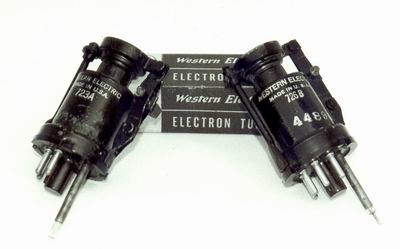 |
| (b) válvulas KLYSTRON;
a esquerda tipo 723A em bulbo metálico sintonizada por
um tipo de cavidade interna; a direita tipo 726B, com
potência de 150 mW para freqüências de 2,9 e 3.4
GHz. |
acts as amplifying element.
However, the early types of KLYSTRON had low gain and inadequate
operation as a microwave amplifier. Soon the engineers developed
a more robust type of valve using several cavities as well
as, dish-shaped cathode allowing higher electron emission.
This new valve was known as the MULTI CAVITY KLYSTRON. Finally,
a new concept was developed. In this way, instead of amplifying
the signal in several sucessive cavities resonators, the new
idea consists to have the electron bean flowing several times
through only one cavity giving birth to the REFLEX KLYSTRON.
(b)
In 1943, in the middle of the WWII, the Germans captured from
the British a new type of microwave valve use in the first
ASV centimetric radar. It was the MAGNETRON.
It amounted to a disaster for the Germans when, having at
last captured such kind of valve, they refused to credit the
Bristish with being able to make such advanced kind of radar.
This strategical error led to the U-boat holocaust of spring
1943 as ships and aircrafts equipped with the
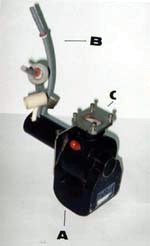 |
(c) moderno
MAGNETRON usado em radares aeronáuticos onde:
a)imã de alta coercitividade
b) conectores
c) saída de rádio-freqüência. |
Airborne Detection of Surface Vessels Radar - ASV - put down
22 out of 36 U-boats sunk.
The history of valve MAGNETRON, started in 1918, with the
researches of the American physicist Albert Hull to control
the electronic flow in a diode, under the influence of a magnetic
field.
Basically, the MAGNETRON, is a high vacuum thermionic valve
consisting of a
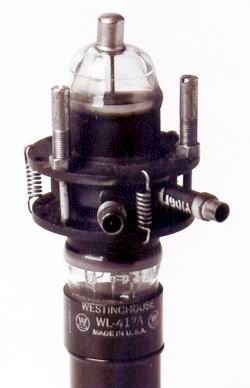 |
| válvula Klystron, tipo WL-417
ou VT-277, para operação em faixas de freqüências
de 2650-3330 MHz. Fornecida em base octal, com tomada
para cabo coaxial e sistema de sintonia mecânica. |
filament located in the center of a cylindrical anode in
such away the electron stream is submitted to a uniform magnetic
field generated by a coil surrounding the valve and, thus,
used to control unidirectionally the flow of the current.
Previous MAGNETRONS were able to generate relatively low radio
energy, typically a few hundred watts. However, from 1920-1930
many were the studies and researches developed to improve
its performance. Among them are the researches developed in
England by the physicists John Randal and Henry Boot working
for the department of Physics of the university of Birmingham.
Such researches led to the "cavity" MAGNETRON, originally
based in the concept of multipe resonator cavities proposed
by the physicist A. Samuel of Bell laboratories in the U.S.A.
In this new type of valve, the original pure tungsten cathode
was surrounded by the anode made of a thick copper ring, which
now consists of the 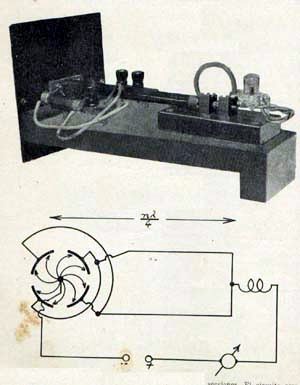 original
cylinder plus additional cylinders cavities connected by slots.
The diameter of the cavities that controls the frequency of
oscillation. original
cylinder plus additional cylinders cavities connected by slots.
The diameter of the cavities that controls the frequency of
oscillation.
In the beginning of 1940, it could be found such a kind of
valve with 6 cavities using tungsten-thoriated filament capable
to dissipate 400 W, operating in a frequency range of 9.9
cm in continuous rate. However, the valve rarefation was still
made by an external vacuum pump.
Due to increasing pressure of the war spreading worldwide,
led to the development of more sophisticated weapons. Around
1941 the British physicist E. Megaw, working in a joint venture
between the Bristish Admiralty and the subsidiary of General
Electric Company in England, developed a full metal MAGNETRON,
using a permanent magnet and a tungsten-thoriated filament
capable to dissipate 1 kW operating in a frequency range of
10 cm.
The continuous technological evolution of the MAGNETRON was
the basis for the development of a new and sophisticated kind
of weapon, the radar, and so the modern electronic warefare
was borne. (c)
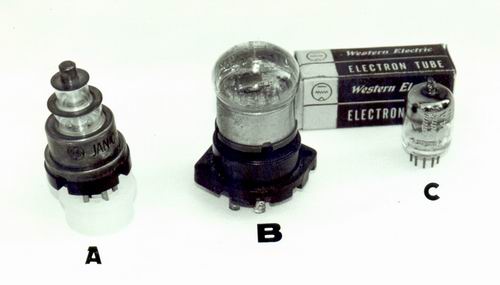
|
Vary valves of high frequency
military job:
A) Type Jan CG 2C40 - triode to glide manufactured for
GE for operation in used frequencies of up to 3 GHz in
equipment of air reconnaissance type IFF, Identification
Friend or Foe.
B) Type 717, pentodo of RF manufactured for the W. used
Electric in periods of training of audio-frequency and
highly and extremely high frequency, for RADAR and altimeters.
C) Type 404 - pentodo miniature manufactured for the W.
Electric, used in amplifiers of VHF of high profit. |

|
Válvulas tipo Acorn desenvolvidas originalmente
pela RCA, EUA para uso em estágios de VHF e UHF.
À esquerda tipo 954, pentodo e à direita
tipo 955, triodo com potência de 1.6W ambas usadas
em equipamentos de RADAR.
Valves Acorn type developed originally for the RCA,
U.S.A. For use in UHF and VHF band. Left, pentodo 954
type, and right type 955, triode with power of 1.6W
both used ones in RADAR equipment.
|
|